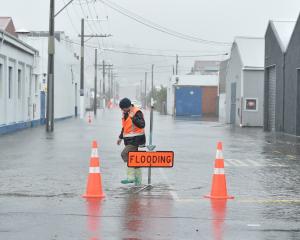Sir Bernard Fergusson wore a monocle, ensuring no one could possibly mistake him for being anything other than an Englishman - even though he was the Governor-General of New Zealand between 1962 and 1967.
But, what feature would help the modern New Zealand Governor-General stand out as 100% pure Kiwi in a crowd of Governors-General at a cocktail party in say, Ottawa or Canberra or London or New Delhi or Belmopan?
Picture a warm tropical evening, a banquet hall with a marble floor the size of a rugby paddock, a generous sprinkle of men in tuxedoes and women in gowns of many hues; waiters with trays of hors d'oeuvre and Champagne and an orchestra accompanying the idle chatter.
Suddenly, there is a hush. Down the wide curving stairway, into the throng of Governors-General and functionaries from 53 Commonwealth member states comes the Governor-General of New Zealand.
What should he or she look like? What should he or she say? How should he or she act to ensure everyone in the room turns and says, in unison: "Surely, that can be none other than the Governor-General of New Zealand."
Well, there are parts of the Kiwi culture you can be almost certain no one else in the entire Commonwealth will have copied and can therefore be regarded as strong indicators a Kiwi is in the room.
The most striking would have to be the facial tattoo or moko. No matter the ethnicity of the next Governor-General, a tattoo of this sort would make him, or her, unmistakably, a Kiwi.
At one time it might have been said it was de rigueur for a Governor-General to wear a black singlet and gumboots to truly represent New Zealand.
Today he or she would be a more distinctive Kiwi wearing a gang patch - although that should be regarded strictly as day wear.
For evening wear the Commonwealth expects the Kiwi to dress formally in the black blazer with the silver fern on the lapel. The tie should be sober and there should be jowls or, in the case of female Governors-General, a large brooch.
To travel to the cocktail party, the Governor-General should probably eschew the government limo in favour of a straight-six Holden with mags, ideally towing a boat with an outboard bigger than an adult Aussie.
Where possible, the nose and forehead of the Governor-General should show signs of recent sunburn.
"Gidday" will still carry the day as a universal Kiwi greeting and the handshake will be firm to overpowering and just a little too long.
The Kiwi Governor-General will make extensive use of the "schwa" vowel, as it is known, so that chips become "chups".
He or she will be amused by the failings of other, taller poppies than him or herself. Jokes though will never be about lower poppies than him or herself - thereby ensuring the Governor-General is politically correct at all times.
There will be no use of irony.
Beer will still be the beverage of choice with perhaps a sav chaser, or two.
He or she will make a pronouncement about the coffee, whether good or bad, and other Governors-General will nod politely because a Kiwi Governor-General can be relied upon to know a good cup of coffee.
If the function is on Friday night, he or she will have missed having fish and chips with his or her kids but will, of course, slip a little something from the buffet table into a pocket to take home.
And, after an emotional haka, the Governor-General will put his or her black blazer back on and head for the Holden, probably stopping on the way to the carpark to take a leak in the flower garden.
GOVERNOR GENERALS THROUGH TIME:
Sir Arthur Espie Porritt (1967-1972)
New Zealand's first New Zealand-born Governor-General. Born at Wanganui in 1900. A surgeon, he worked mainly in England but returned to New Zealand in 1967 as the country's 11th Governor-General. He returned to England in 1972 where he died, having declared he had become a "complete Pommy", but "never ceased to be a New Zealander".
Sir (Edward) Denis Blundell (1972-1977)
Born in 1907 in Wellington. Educated at Waitaki Boys High School and Cambridge University. A lawyer, he was appointed High Commissioner for New Zealand in Britain and ambassador to Ireland in 1968.
Rt Hon Sir Keith Jacka Holyoake (1977-1980)
First politician appointed Governor-General. Born in 1904 and educated in Tauranga, Hastings and Motueka. PM 1960-1972.
Sir David Stuart Beattie (1980-1985)
Born in Sydney in 1924. Brought up by his mother in Auckland. Supreme Court judge (1969-1980).
Rt Rev Sir Paul Alfred Reeves (1985-1990)
First Maori Governor-General, belonging to the Puketapu hapu of Te Atiawa of Taranaki. Born in Wellington in 1932. Archbishop of New Zealand in 1980.
Dame Catherine Anne Tizard (1990-1996)
First female Governor-General. Only child of Scottish immigrants, born in Auckland. Mayor of Auckland 1983-1990.
Sir Michael Hardie Boys (1996-2001)
Born in Wellington. Appointed a High Court judge in 1980. He was appointed to the Court of Appeal and became a Privy Counsellor in 1989.
Dame Silvia Cartwright (2001-2006)
Born in Dunedin. Studied law at the University of Otago in 1967. The first woman appointed to the High Court.
Sir Anand Satyanand (2006-2011)
First Governor-General of Indian and Pacific ancestry. Born and raised in Auckland. Parents were born in Fiji and migrated to New Zealand, while his grandparents were born in India and had migrated to Fiji. In 1995 he was appointed a Parliamentary Ombudsman, serving two five-year terms.






















